This month’s photograph of George Bell and Sons grocery store in Elder St Lambton was taken exactly 125 years ago in May 1896. It is not only a reminder of how our visual landscape has changed, but also how our way of life has changed, as seen in the two themes of Tea and Transport.
A riddle published a century ago asks: Why is a grocer a heavy person? Because his business always makes him weigh tea (weighty). Although not side-splittingly funny, it’s a reminder that while we now purchase tea in mass produced robotically dispensed plastic wrapped packages, grocers like Bell bought commodities such as flour, sugar and tea in bulk then sold it to their customers by weighing out the requested quantity for each individual purchase.
From about 1880 tea began to be distributed and sold in small packets of set weight. There were two reasons for the change. The weighing and packing of each purchase took considerable time, incurring great expense to every grocer doing even an ordinary trade. Pre-packaged tea also benefited the customer, preventing grocers making a bit of sly profit by wrapping the tea in extra heavy paper before weighing, or by adulterating it with other substances.
Not that George Bell would have practised such deceits. He was held in high respect, as evidenced by the hundreds who attended his funeral in November 1887. A few weeks earlier while travelling in a horse and buggy near Sandgate Cemetery, the horse was startled and then bolted, capsizing the buggy. George suffered serious head injuries from which he never recovered and he died aged just 58.
It is tempting to imagine travel by horse and cart as a serene and idyllic experience. In truth it was dangerous, and newspapers regularly reported on serious injuries and fatalities related to horse drawn transport. Although tragically, serious accidents still occur now on our roads today, travelling today is considerably safer than in the times of George Bell.
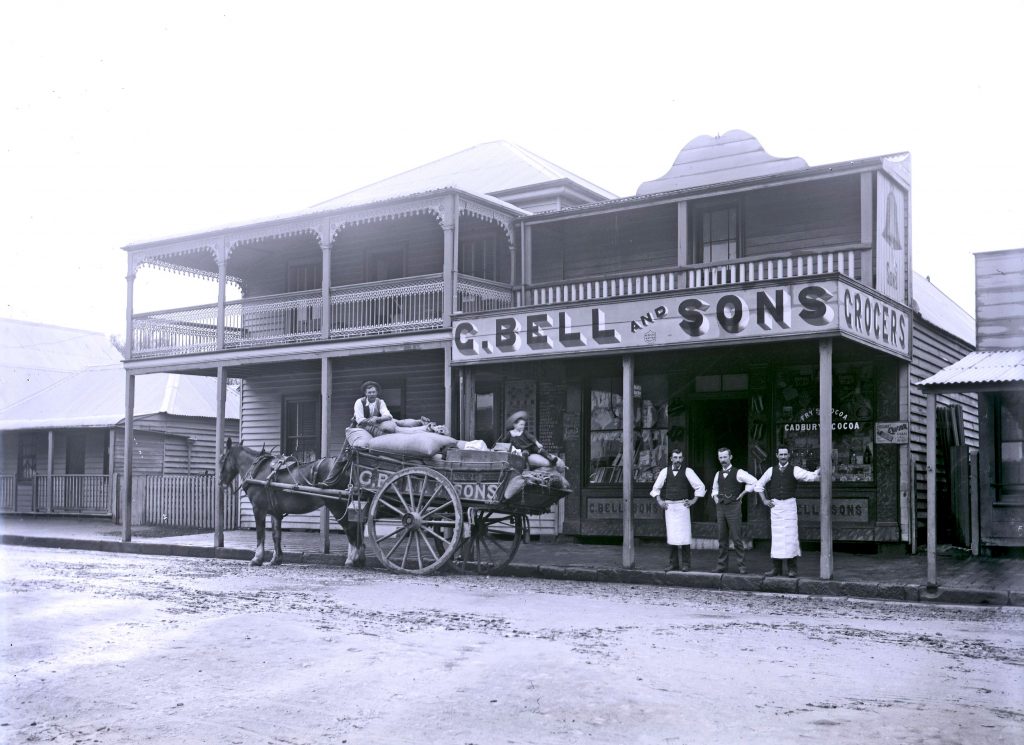
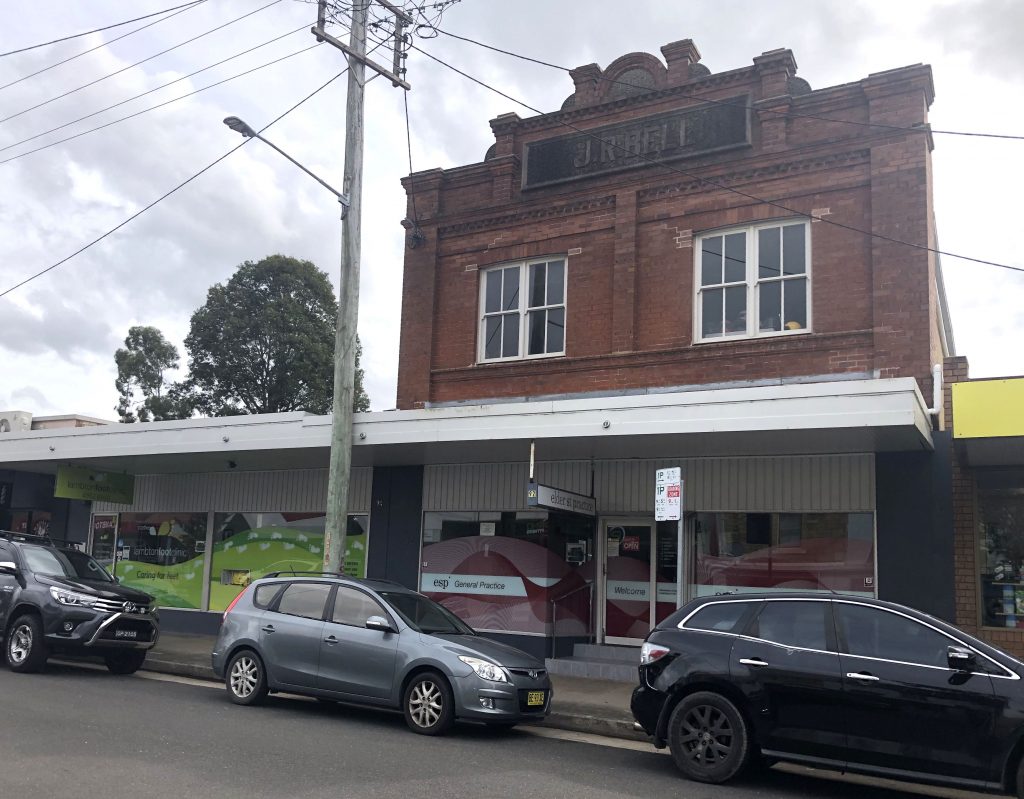
The article above was first published in the May 2021 edition of The Local.
Additional Information
Packet Tea
Some of the information in my article relating to the sale of tea, came from a University of Sydney Bachelor of Arts (Honours) dissertation by Jessica Knight from 2011, entitled “A Poisonous Cup? Afternoon Tea in Australian Society, 1870-1914.”
In particular, the paragraph commencing at the bottom of page 16 was insightful.
The introduction of pre-packaged teas, as opposed to bulk tea which was usually packaged in large tea chests, marked a shift in both sales and consumption of tea. For example, the Asiatic Tea Company opened in 26 May 1881 in Pitt Street to sell their packet teas. The justification they provided for packet tea was that “tea being so universally used in Australia, the consumption consequently is very great, the weighing and packing of which takes considerable time meaning additional expense to every grocer doing even an ordinary trade, while in country towns where experienced grocers’ assistants are difficult to be obtained, the weighing and packing of tea became a source of annoyance to the storekeeper – hence the great advantage to them in the use and general sale of packet teas”. The Company’s success was so great that they soon needed to move to larger premises, and they grew to include supplying packet tea to storekeepers across the city of Sydney and in wider New South Wales. Mirroring the increasing commodification of tea in Britain, these tea shops indicated the success of tea commercial enterprise within Australia, and thus provide tangible support to the interconnectedness of the Empire.
page 16 of Jessica Knight’s dissertation.
The extent of the problem of inferior tea being sold by the illicit mixing in of other substances can be gleaned by searching Trove for the phrase “tea adulteration”. The Argus of 9 April 1881 reported that …
The various methods of adulteration of tea may be defined as the addition of leaves other than those of tea except those used for scenting exhausted tea leaves and damaged tea; an undue proportion of stalks or vegetable matter foreign to tea of any kind whatever; foreign mineral matter especially sand, quartz, soapstone, China clay, magnetic oxide of iron. Lastly the substances used for artificially colouring or painting the teas as ferrocyanide of iron, or Prussian blue indigo, turmeric &c.
An example of adulteration can be seen in this 15 February 1898 report, where a grocer was charged for selling tea “of very inferior quality” that had been adulterated with plumbago (a garden shrub). The grocer blamed the merchants he had bought the tea from.
Elder Street store
Vol-Fol 99-214 shows that “George Bell of Lambton, Miner” purchased Lot 8 of Section E of Lambton township in 1870.

Ownership of the land remained in the Bell family until 1965.
- 1889 – George Edward Bell
- 1899 – Ann Bell (widow of George Edward Bell)
- 1904 – George Reavely Bell
- 1909 – Elizabeth Bell (Widow of George Reavely Bell)
- 1952 – Sydney Raymond Bell
- 1965 – Doris Lila Janssen and Myra May Edwards
Although from the exterior it appears that the George Bell’s residence (to the left of the store) no longer remains, there is in fact a few rooms at the rear of the building that were retained, one of which is used as a lunch room by the Elder Street Practice. This room has an ornate fireplace, timber floor, wood panelled skirting boards, and pressed metal ceiling.

Hunter Street stores
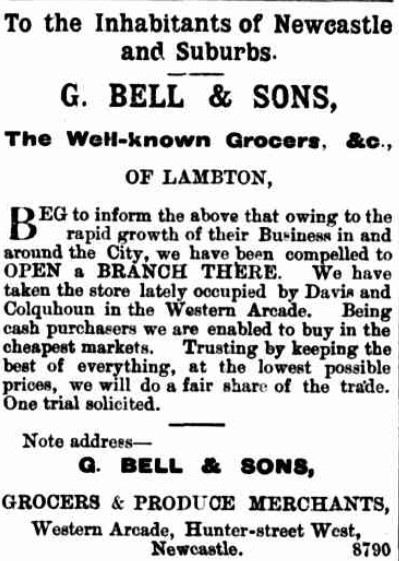
The Western Arcade was located at 684 Hunter St, It was originally erected in 1888 as the The Elite Skating Rink. The site later became the Palais Royale, and was eventually demolished to make way for KFC.
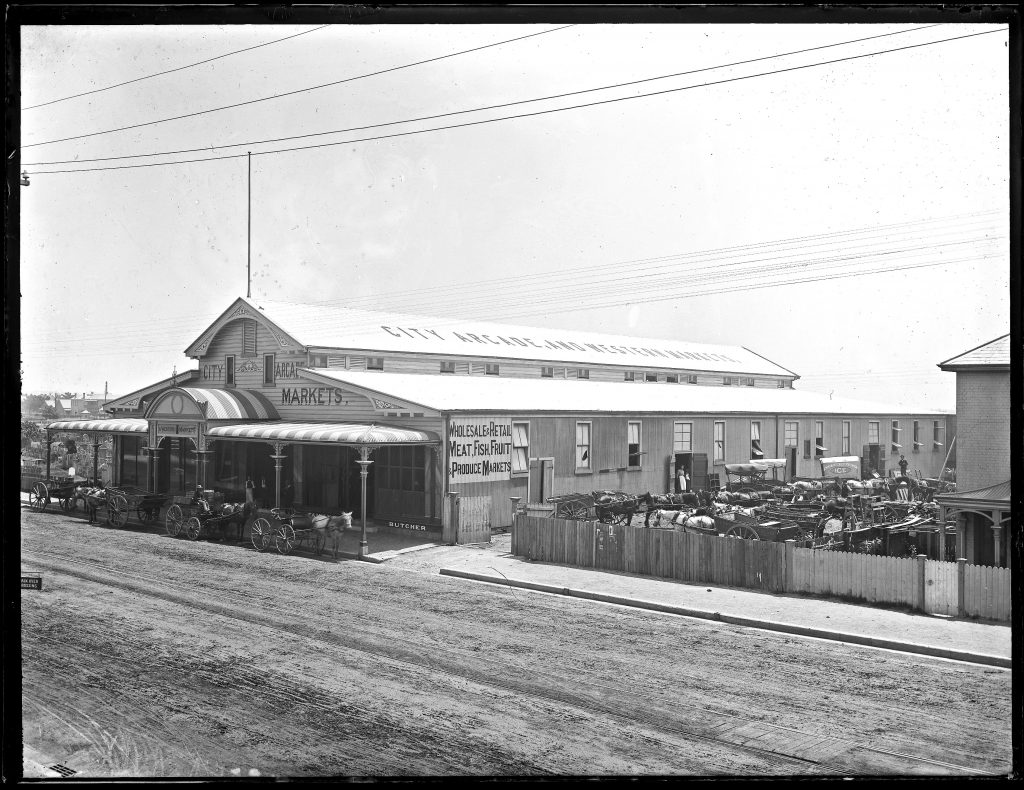
In 1897, the firm erected their own premises on in Hunter Street West.

This new store was located at 545 Hunter Street, and the building remains today.
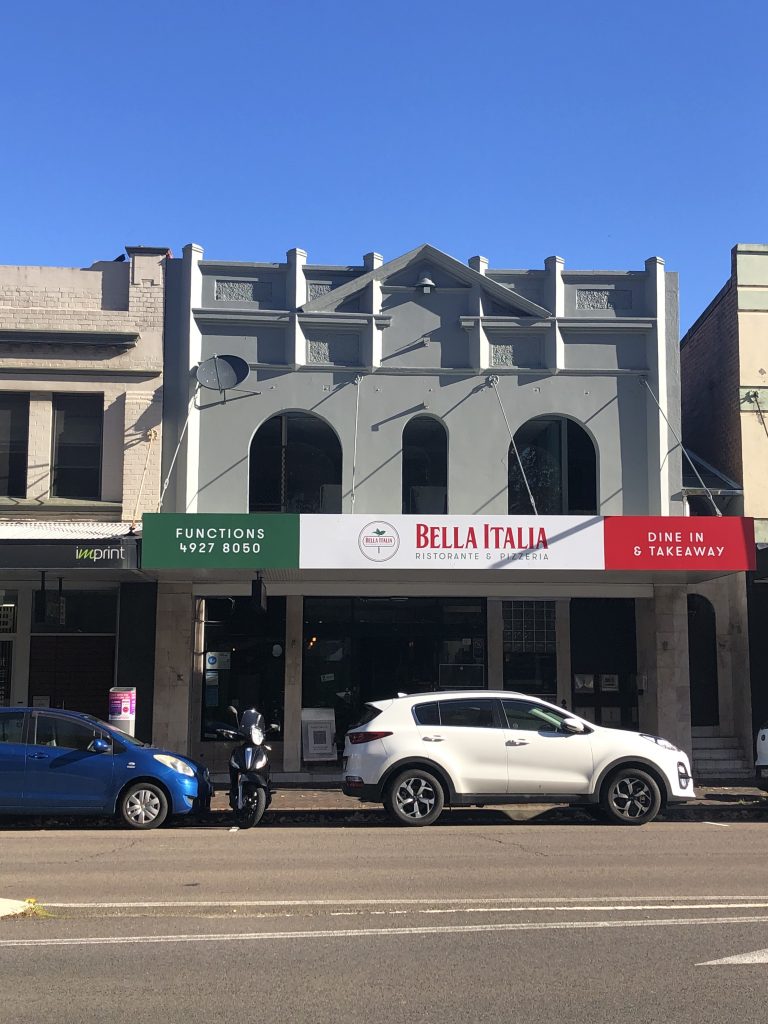
Note the bell sculpture at the top of the building façade, alluded to in their advertisement.
In a similar fashion, their Elder St Lambton store in 1896 had a picture of a bell painted on the side wall.
An advertisement for Bell’s store from 1902, shows how ingredients such as sugar, tea and flour were sold by the pound. Note also that the address of “261 Hunter-Street West” is the old number, before Hunter street was re-numbered
Death of George Bell
SERIOUS ACCIDENT.–We regret to learn that a serious accident occurred yesterday to Mr. George Bell, storekeeper, Lambton. It appears that Mr. Bell, with two of his sons, was driving in a sociable. When in the neighbourhood of Sandgate Cemetery the king-bolt of the vehicle gave way, and the shaft fell, frightening the horse, which immediately bolted. The vehicle was capsized, and the occupants were thrown out with much force, the result being that Mr. Bell was severely injured about the head, while one of his sons was much injured about the face. Assistance was lent by some passers by, and Dr. Nash, of Wallsend, having been sent for, applied the usual remedies in order to bring Mr. Bell to consciousness. It was, however, about an hour and a half before the patient rallied. A cart was obtained from Hexham, and he was conveyed from the scene of the accident. Concussion of the brain is feared, and Mr. Bell lies in a critical condition.
Newcastle Morning Herald and Miners’ Advocate, 31 October 1887
The LATE Mr. GEORGE BELL.–The deep regret felt for the death of the above gentleman, and the general respect in which he was held, was very evident yesterday, Monday, seeing the large number that came to pay their last tribute of respect by attending the funeral. The Lambton residents were present in hundreds, and others from Newcastle, Wallsend, Waratah, and other places, a good many being business people, and amongst whom were representatives of some of the leading business houses in Newcastle. Altogether the funeral cortege was one of the largest that left Lambton, and made up as it was of hundreds of foot passengers, numerous buggies, ‘buses, and other vehicles, and horsemen, the length covered was little short of a mile. Prior to leaving the deceased’s late residence, the Rev. Mr. Walters, of the Primitive Methodist, conducted a short service, the remains were then placed in the hearse, following which came the sons of deceased, then a mourning coach with other relatives and intimate friends, and then the long procession. The members of the now defunct Lambton band, with some of the Volunteer Band, to show their respect, mustered fourteen players, and marched in precedence of the hearse, playing the solemn strains of the ” Dead March in Saul.” The funeral went through Waratah to the North Waratah Cemetery, where the Rev. J. P. Ollis conducted the impressive service of the Church of England, and thus the last act to one who in life was respected for his uprightness of character, and deeply lamented and truly honoured in death.
Newcastle Morning Herald and Miners’ Advocate, 22 November 1887.
Newspaper articles
| Article Date Event Date | Notes |
|---|---|
| 12 Sep 1870 | First mention of George Bell in the newspaper - signatory in a petition for the formation of Lambton Municipality. |
| 18 Jul 1871 15 Jul 1871 | At a public meeting, George Bell is nominated for the first Lambton council election. His name does not appear on official list of nominees on 29 Jul 1871 - either his nomination proved to be invalid, or he withdrew. |
| 9 Dec 1875 | In Elder-street, a couple of commodious two-storied buildings, that have been in course of erection for some time, are now completed. The shops are owned by Messrs. Bell and Wilson, the former of which has now opened as a grocer. |
| 17 Jul 1879 13 Jul 1879 | "As Mr. and Mrs George Bell and Mr. E. Reavely were driving down Turton Road, they had a narrow escape from serious injury. When near Thompson's Hotel the winkers became loose, and the horse at once bolted, keeping straight on until near Merchant's Hotel, where the vehicle capsized, throwing the whole of the occupants out on the street. They, however, strange to say, escaped with out much injury beside a severe shaking." |
| 19 Apr 1882 | "Mr. George Bell, one of the most enterprising of our local business men, is having a new residence erected adjoining his stores in Elder-street. The building, is of a substantial character, and judging from the plan will be one of imposing appearance when completed." |
| 31 Oct 1887 30 Oct 1887 | Serious horse and buggy accident in which George Bell suffers critical injuries. |
| 26 Nov 1887 19 Nov 1887 | "Death. BELL. — At Lambton, on the 19th instant, Mr. Mr. George Bell, storekeeper, aged 58 years, leaving a widow, three sons, and two daughters to mourn their loss." |
| 22 Nov 1887 21 Nov 1887 | Funeral of George Bell. |
| 2 Dec 1887 | Estate of George Bell to go to his eldest son, George Edward Bell. |
| 16 Nov 1888 | Yet another horse related accident associated with the Bell family - a young man making deliveries to the store is run over by a cart. |
| 7 Jul 1894 | G. Bell & Sons have opened a branch store in the Western Arcade, Hunter Street West, Newcastle. |
| 17 Dec 1897 | "G. BELL & SONS (ESTABLISHED 1870) beg to intimate that they have THIS DAY OPENED IN THEIR NEW PREMISES, IN HUNTER-STREET WEST, Next the West End Post Office. LOOK FOR THE SIGN OF 'THE BELL' OVER G. Bell and Sons." |
| 17 Dec 1897 | "MESSRS. G. BELL & SONS. This old established firm of grocers, drapers, and general provision dealers has been among the leading houses in the trade since 1870. Three years ago they opened a branch of their Lambton business at the Western markets. Recently to meet their increasing trade a more central site was purchased, next to the Post Office, Hunter street West, upon which they have just erected imposing business premises." |
| 7 Mar 1928 | In 1928 the grocery business in Elder Street was being run by Elizabeth Bell, but not in a very hygienic manner, with the Health Inspector even finding spiders and cobwebs in the cheese safe! |

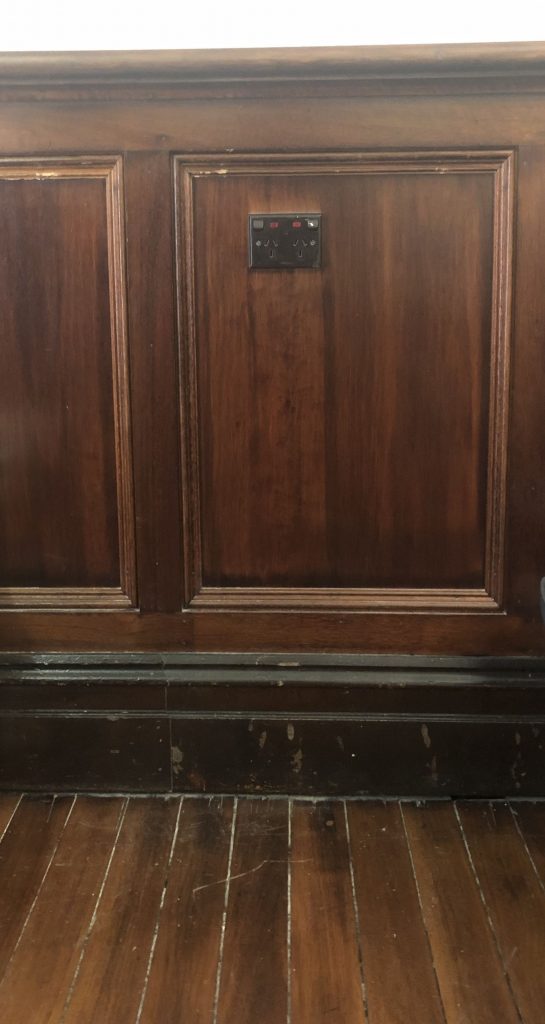

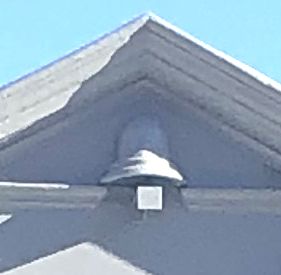

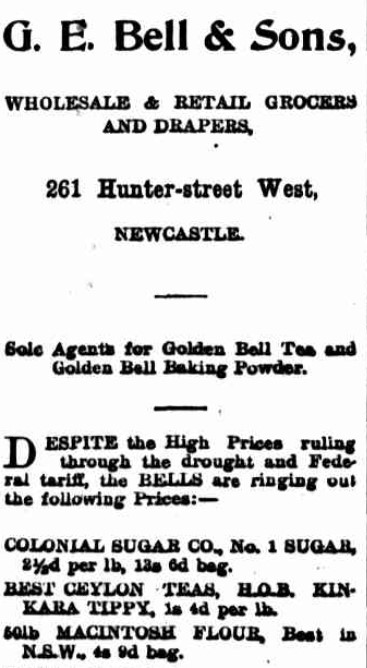
Vic Bell, an Alderman for Newcastle Council, lived in Jesmond. Was he related to George Bell?
Good question. I don’t know for sure, but I don’t think so.
Victor Charles Bell was the son of Septimus Bull, who was the son of William Bell. In an article on the death of William Bell’s wife Isabella in 1931, the biographical details do not line up in any way with George Bell the grocer.